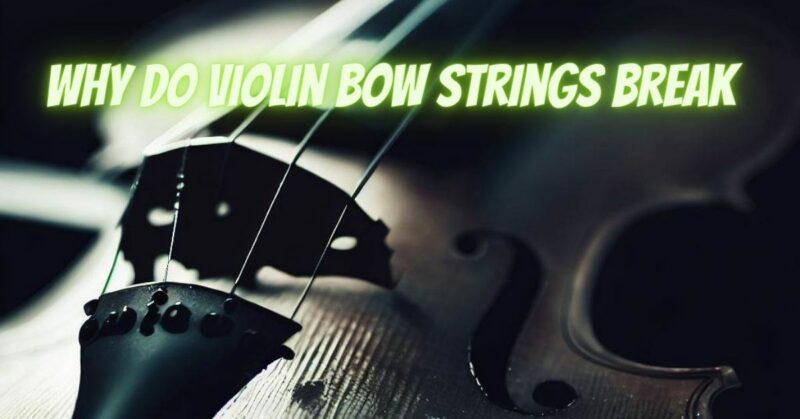As a violinist, encountering a broken bow string can be frustrating and disruptive to your practice or performance. Understanding the reasons behind bow string breakage can help you take preventive measures and ensure a longer lifespan for your strings. In this article, we will explore common causes of violin bow string breakage and provide tips on how to prevent it from happening.
- Natural Wear and Tear:
Over time, bow strings can weaken and break due to regular usage and natural wear and tear. Factors that contribute to this include:
- Tension: Excessive tension applied to the bow strings can gradually weaken them. It is important to properly adjust the tension and avoid over-tightening the strings.
- Rosin Buildup: Excessive rosin buildup on the strings can increase friction and wear, making them more prone to breaking. Regularly clean your strings to remove excess rosin buildup using a soft cloth.
- Incorrect Technique:
Improper bowing technique can put unnecessary strain on the strings, leading to breakage. Consider the following aspects of technique:
- Bowing Angle: Using an incorrect bowing angle, such as too much pressure or an extreme angle, can cause excessive stress on the strings. Ensure you maintain a balanced and relaxed bowing technique.
- Bow Placement: Placing the bow too close to the bridge or fingerboard can cause uneven pressure on the strings, increasing the risk of breakage. Aim for a consistent and centered bow placement.
- Bow Speed: Abrupt changes in bow speed, such as sudden accelerations or decelerations, can strain the strings and potentially lead to breakage. Practice smooth and controlled bowing to minimize stress on the strings.
- Environmental Factors:
Environmental conditions can play a significant role in string breakage. Consider the following factors:
- Temperature and Humidity: Extreme temperature changes or low humidity levels can cause the strings to contract or expand rapidly, making them more vulnerable to breakage. Avoid exposing your violin to drastic temperature changes and maintain proper humidity levels.
- Storage Conditions: Improper storage, such as leaving the violin in an excessively dry or humid environment, can affect the strings’ integrity. Store your violin in a case with appropriate humidity control and insulation.
- Age and Quality of Strings:
Old or worn-out strings are more likely to break. As strings age, their structural integrity weakens, making them more susceptible to breakage. Additionally, low-quality or poorly maintained strings may have inherent flaws or weak points that can lead to premature breakage.
Preventive Measures:
- Regular Maintenance: Regularly inspect your bow strings for signs of wear, fraying, or discoloration. Replace any worn-out or damaged strings promptly to prevent breakage.
- Proper Rosining: Apply an appropriate amount of rosin to the bow hair to ensure optimal grip without excessive buildup. Clean the strings regularly to remove excess rosin.
- Correct Technique: Practice proper bowing technique, including bow angle, placement, and speed. Seek guidance from a violin teacher or coach to refine your technique and minimize strain on the strings.
- Climate Control: Maintain a stable environment for your violin, avoiding extreme temperature and humidity fluctuations. Use a humidifier or dehumidifier as needed to regulate humidity levels.
Conclusion:
Understanding the reasons behind violin bow string breakage and taking preventive measures can help you avoid disruptions during practice or performance. By addressing factors such as natural wear and tear, incorrect technique, environmental conditions, and the age and quality of the strings, you can prolong the lifespan of your bow strings and enjoy uninterrupted playing. Regular maintenance, proper technique, and creating a suitable environment for your instrument are essential for preventing bow string breakage and ensuring a more enjoyable and productive violin playing experience.

